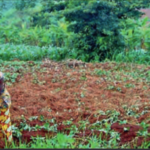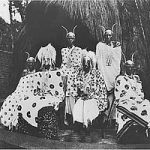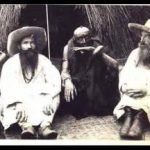Belgian Colonial Economic Policies
Like colonialadministrations elsewhere, the Belgian administration in Ruanda-Urundi had to confront the problem of how the colony was to support itself; obtaining revenues to support the colonial enterprise became particularly critical during the global economic crisis of the 1930s. Under German rule, the export taxes on various products, especially hides, had served as an important source of revenue; localized attempts to introduce a hut tax (after 1913) had met with only limited success. Hides continued to be an important revenue-producing export in the early years of Belgian rule. In the 1930s, these revenues were supplemented by taxes levied upon mining installations established in the colony (primarily in the eastern area of Rwanda). But gradually, Belgian colonial revenues came to rest on individual taxation and on the extension of export taxes on food and cash crops (produced principally by smallholders). Key features of Belgian economic structures in Ruanda-Urundi from the mid-I920s were tax collection (carried out by the chiefs), as well as, in some areas, labor recruitment, and the encouragement of food and cash-crop production. From the mid-1920s both food and labor were exported to serve the interests of economic order in the Congo.
The system of tax collection imposed by the Belgian administration was relatively effective: By 1931-1932 revenues from direct taxes on rural people constituted about 50 percent of revenues for Ruanda-Urundi. And early official reports stressed this region’s agricultural potential. The high population density, fertile land, and abundant rain-fall of Rwanda and Burundi were seen to offer enormous possibilities for providing food to the much larger and less densely populated Congo. For example, a 1923 report by the Belgian administration in Ruanda-Urundi praised the inclusion of the colony in a customs union with the Congo, which, it claimed, had already had a profound impact on the agricultural development of the country which will soon be able to provide enough local foods to feed the industrial centers of the Congo. The report noted the emphasis in earlier reports on the potential of agriculture as the most important economic resource of the country, and commented, “This possibility has become a reality, and the role of this country as a source of food for Katanga [the copper-mining region in the southern part of the Congo] is being increasingly confirmed.” In addition to food, however, the people of Ruanda-Urundi were to supply the Congo with labor as well. We have seen that recruitment of workers for the mines of Katanga began in Ruanda-Urundi in 1925, with a small group of 216 men and a few wives and chi1dren. The number of recruits increased rapidly during the next five years, reaching a total of more than 7000 by 1929. Many Rwandans also went to Kivu province in eastem Congo to work on plantations or in service jobs in the embryonic urban centers.
Recruitment for the Katanga mines was halted in 1930 (it would not be resumed until 1949), and exports of food from Ruanda-Urundi to the Congo were temporarily suspended in the late 1920s in the wake of widespread famine. Food shortages had appeared in some local areas of Burundi in 1922 and 1923 with devastating impact. Famine spread to other areas of Burundi in 1924 and hit the eastern and central regions of Rwanda as well. While the worst of the famine ended in 1926, famine conditions recurred in various local regions of Rwanda and Burundi for several years thereafter. Nevertheless, food was exported from Ruanda-Urundi to the Congo in 1924 (3308 tons) and, in diminished quantities, in 1925 (2615).
The famine of the 1920s and the worldwide depression which followed closely on its heels mark an important turning point for Belgian policy in Ruanda-Urundi. Ostensibly to counteract the famine, the administration introduced a series of programs that required vastly increased demands on rural manpower and set forth an explicit policy of reinforcing the power of the chiefs, who were responsible for seeing that each directive was carried out in all its details. The measures included the imposition of compulsory cultivation of famine-resistant food crops (cassava, sweet potatoes and, in some areas, European potatoes), reclamation of marshes to provide additional land for cultivation, the introduction of required cash crop production (primarily coffee) and reforestation programs. In addition, the administration introduced an ambitious program of roadbuilding.
Introduced in Rwanda in the mid- and late-1920s, these measures were substantially intensified during the Depression and in 1937 began to be supplemented by an anti-erosion program. This was really much more than an anti-famine campaign. It can best be understood as part of a larger effort on the part of the state to control and charnel African labor, directing it toward projects that would contribute to the revenues of the state, either directly (through the head tax and taxes on exports) or indirectly (through facilitating the operations of European companies and, in Kinyaga, of settlers, whose activities were regarded as important to the economic growth of the colonyl.
The emphasis on forced peasant production reflected in part the out-come of an intense debate in Belgian colonial circles, a debate precipitated by the Depression, on the economic future of the Belgian Congo. Boom conditions in the 1920s had resulted in rapid expansion of commerce and industries in the Congo. The depressed prices of the 1930s led to massive layoffs in the- industrial sector and a reevaluation of the economic policies of the colony. One result was a renewed interest in peasant agricultural production in the Congo, to be based on coerced labor regialated by the state.” Proponents of policies requiring Africans to grow minimum acreages of food or non-food cash crops saw these as humanitarian and “educational” measures. The goal, they asserted, was to guard Africans against famine and to provide incomes for small-holders. Critics, while accepting the need for greater emphasis on agriculture, deplored the resort to coercion. Some pointed out that production levels had not been a problem in the 1920s when prices paid to producers were high enough to constitute incentives. Others alleged that the main purpose of the policy of forced production was to ensure availability of local products at very low prices, which European exporters in the Congo could buy cheaply (and still sell for a profit on the depressed world markets) or, in the case of food crops, which would provide regular supplies of food cheaply to industrial enterprises such as mines. As Merlier has pointed out:
Obligatory crop cultivation (referrecl to as “educational”) was used to stabilize the balance of trade which still brought in four billion [francs] from 1931 to 1937: in contrast to the policy of mineral production, a drop in the world agricultural markets was met with an increase in production and especially with a reduction in peasant incomes.
In Ruanda-Urundi, a crucial component of policies for mobilizing rural labor was a renewed commitment on the part of Belgian authorities to “respect and reinforce” the power of “indigenous authorities” (by which was meant Tuutsi chiefs). Articulated in the program of Governor Voisin in 1930, the policy instructed European administrative personnel to keep in mind that “without the collaboration of indigenous authorities, the occupying power would find itself powerless and faced with anarchy.” The Voisin program called for more careful supervision of chiefs “to avoid abuses in the area of prestations and customary corvées,” and specified that the chiefs who were judged “incompetent” would be dismissed and replaced. By the mid-1930s, the chiefly cadre in Rwanda was smaller in number and better educated than in the past: in 1935, 60 percent of the 969 chiefs and subchiefs in Rwanda were literate, and over 80 percent of them were Christians (overwhelmingly Catholic), Chiefs were also more closely supervised and supported by the European administration, particularly in the area of obligatory work, tax collection, and labor recruitment.
The system was not, however, designed to limit abuses. The chiefs were expected to supervise and enforce the system of obligatory cultivation; they were to mobilize labor for roadbuilding, reforestation and building various installations for state activities (such as rural hospitals and dispensaries). And now chiefs were also to become major coffee growers, presumably by making use of “traditional” tribute in labor (ubureetwa) on the part of the general population. Finally, one of the most important roles of the chiefs and subchiefs was to collect taxes. From the point of view of the Belgian colonial authorities, the stream-lining of administrative structures, accomplished through the regroupment program of chiefdoms and subchiefdoms and the removal of “incompetent chiefs,” was an important means of improving the efficiency of tax collection. Census records were compiled more precisely, and chiefs were instructed that tax collection was a central feature of their job.
The removal of Umwami Musinga from office in 1931 coincided, not accidentally, with these efforts to increase the ability of chiefs to impose state-mandated demands upon the population. Musinga’s son Rudahigwa was designated as successor to his father, not according to Rwanda tradition but by the Belgian colonial authorities and the Catholic
Church in Rwanda. One of Rudahigwa’s first official acts (for which he was lavishly praised by the administration) was to abolish prestations in kind made to the chiefs and the king. These were replaced by a money payment (with a portion allocated to an official at each level: subchief, chief, and king) to be collected at the same time as the annual head tax. This change provided additional incentives for Rwandan chiefs and subchiefs to collect taxes, since their own income was determined directly as a proportion of the taxes they collected.
By 1937 an estimated 41,000 hectares of marshland had been drained and prepared for irrigated cultivation; of these more than 30,000 hectares had been planted with crops. Some 7000 hectares of reforestation plots had been planted, and the road network in Rwanda and Burundi had been increased to more than 6000 kilometers of primary and secondary roads. More than 20 million coffee trees had been planted in the two countries by 1937; of these, 50,000 belonged to chiefs, 700,000 to subchiefs, and 19.8 million to peasants. While in 1927 coffee production from Ruanda-Urundi was about 10 tons, this had risen to 2000 tons in 1937.
One consequence of the forced mobilization of rural manpower and more effective collection of taxes was a marked improvement in the financial situation of Ruanda-Urundi, despite the economic vicissitudes of the Depression. As a result of the world economic crisis and the drastic decline in world prices for primary products, the value of exports from Ruanda-Urundi had plummeted, with a direct impact on the colonial state’s income from customs duties. In both Rwanda and Burundi (as in the Congo) the state weathered the crisis by squeezing the rural population. During the 1930s, the volume of hides and other exports from Rwanda and Burundi rose substantially (making up in part for the reduced value of these exports), and during the same period, the proportion of income for the Ruanda-Urundi state budget coming from the head and cattle taxes rose significantly.
In 1936 the territory of Ruanda-Urundi achieved a balanced budget for the first time. Income that year totaled 35 million francs, expenditures 31,200,000 francs. Revenues from the head tax, cattle tax, and money payments for “traditional” prestations amounted to 16 million francs, some 45 percent of the governmental receipts. Income from export and excise duties and contributions from mining operations provided the major part of the remaining income. Not counted in the budget were the important contributions in unpaid labor provided by cultivators in the chiefdoms that drained marshes, maintained the roads and footpaths, and carried out the reforestation programs.
Impositions on the rural population were further increased after 1937, with intensification of the coffee campaign and an associated program for constructing anti-erosion ditches (rural people were constrained to tenace steep hills to inhibit erosion). Between 1937 and 1945 coffee production rose further, from 2000 tons to 4800 tons. But such export crop production was viewed by many Rwandans as “a European scheme for their own enrichment at the expense of the African.”
Under these conditions, “work” came to be the byword of the dual colonial state during the interwar period and alter:
Thus for several decades the country became a vast camp of forced work of a new type. The very notion of work came to be practically synonymous with corvée, to the point that the representatives of Authority themselves, natives as well as Europeans, understood it as such and interpreted it with this transformed nuance.
Harsh rural conditions, particularly the multiple demands enforced on the population by the chiefs, were important in pushing rural Rwandans to migrate in search of work. In most areas of Ruanda-Urundi, opportunities for earning money were relatively limited, and work conditions and pay were poor relative to neighboring regions in East Africa and the Congo. From the central, southern, and northern areas of Rwanda, many migrated to Uganda or Tanganyika to escape rural exactions and to obtain higher earnings than could be got at home:
This explains the massive emigration of men and able-bodied youth to the British Protectorate of Uganda: they went to look for work as free labor. This exodus reached dramatic proportions in certain areas of the country, such that young women also had to emigrate because they were no longer able to marry, so drained of young men had these regions become.
In Kinyaga and the regions north of Kinyaga along the shore of Lake Kivu, people went west to the Congo or found jobs locally with European settlers in the area. Consequently, those left behind found it all the more difficult to cultivate the required obligatory fields and also fulfill the heavy demands for labor on “public works.”
During World War II the colonial authorities called upon Rwanclans to make significant contributions to the war effort. The conditions of the League of Nations Mandate prohibited the recruitment of Africans in the territory for military service. Instead, the Belgian administration required Rwandans to provide cheap food and cows for slaughter to assure supplies for the industrial centers in the Congo, where stepped-
up production was seen as crucial to the war effort. Cattle-owners were forced to sell their cattle at ridiculously low prices; some men apparently committed suicide seeing their herds decimated in this way. And despite a two-year drought, cultivators were forced to sell beans to European middlemen for less than one franc per kilo; the middlemen later sold these products for enormous profits (beans for at least 5 francs per kilo) in the Congo.
In these conditions, people migrated in larger munbers than ever before to Uganda, leaving behind (in some areas) mainly old people and children. The prolonged drought, labor migration, “harassing corvées which caused serious loss of time,” and the “fléau de profiteurs de guerre” were key elements in the Ruzagayura famine that struck Rwanda in 1943. Relief food supplies from the Congo were not brought in until the end of 1943, a year after the onset of famine; during the course of this food crisis, which lasted two years, at least 300,000 people died. Like the Gakwege famine in the 1920s, the 1943 famine gave rise to intensified impositions on the population: in a decree of 1944, the colonial government ordered that all cultivators were to plant at least 35 ares of seasonal food crops (such as beans, peas, corn); in addition, they were to plant and maintain 25 ares of non-seasonal food crops (a substantial increase over the earlier 10 ares which had been mandated in 1926),which were to include 15 ares of manioc except in regions above 1900 meters, where sweet potatoes, potatoes, or other approved root crops could be substituted.
In Kinyaga, as elsewhere in Rwanda, obligatory cultivation was enforced, roadbuilding and reforestation were pushed, anti-erosion ditches were imposed, and taxes were collected. The demands on chiefs to execute these programs have been noted in much of the literature on colonial Rwanda; oral and archival data from Kinyaga confirm such accounts. Little attention has been given in the published sources, however, to the conflicting relationship of these demands with the role of chiefs as labor recruiters for European enterprises. In Kinyaga, because of the region’s proximity to the Congo, such labor demands contributed substantially to the oppressive character of chiefly rule. At the base of these conditions were contradictory views among European administrators, missionaries, and settlers over the extent to which tabou should be “free” or coerced. Earlier chapters have noted that Kinyaga’s distance from central Rwanda and proximity to different peoples in the west contributed to cultural heterogeneity in the region and affected attitudes of Ndugans toward Kinyagans. Central chiefs tended to disdain Kinyagans and flaunt their “superiority” over them. Kinyagans resented the extension into their region of central administrative forms and institutions. Aside from differences in customs and attitudes, however, Kinyaga’s peripheral location added an important dimension to the nature and impact of economic change in the region. The fertile soils and abundant rainfall in the areas near Lake Kivu, as well as the moderate climate and availability of transport on the lake, served as a strong attraction for European settlers and enterprises. During the 1920s and after, an expansion of plantations and mines in Kivu province of the Congo and in Kinyaga led to opportunities both for the development of smallholder production of marketable food commodities by Africans and for involvement in commerce, as well as to massive demands for labor. These different facets of economic change placed contradictory pressures on local labor supplies, pressures exacerbated by the development of coffee growing in the region by both European settlers and African smallholders. The conflicting demands for main d’oeuvre (manpower) dramatized the incompatible demands being made on chiefs. The active role of the European administrators and chiefs in recruiting labor added to the harshness of demands on the population (already overburdened by various required cultivation schemes and work projects), while at the same time wage labor provided to some Kinyagans channels of escape from administration at home. Both the harshness of administration and the escape which implied participation in wage labor elsewhere contributed to the later growth of overt organized protest against clientship and chiefly rule.
https://uk.amateka.net/belgian-colonial-economic-policies/https://uk.amateka.net/wp-content/uploads/2020/08/colonial_congo.jpghttps://uk.amateka.net/wp-content/uploads/2020/08/colonial_congo-150x150.jpgModel CitizenshipLike colonialadministrations elsewhere, the Belgian administration in Ruanda-Urundi had to confront the problem of how the colony was to support itself; obtaining revenues to support the colonial enterprise became particularly critical during the global economic crisis of the 1930s. Under German rule, the export taxes on various products, especially...BarataBarata rpierre@ikaze.netAdministratorAMATEKA | HISTORY OF RWANDA




